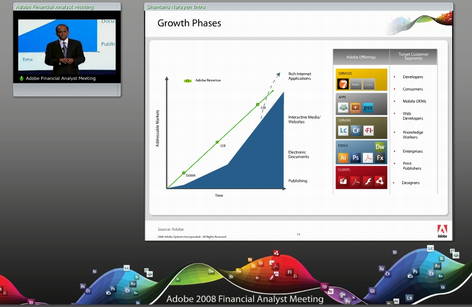Seeking the iPhone in Adobe's annual analyst briefings

Even if you're not an analyst, Adobe's 2008 financial briefings available online make interesting viewing, from its showcase of new AIR tools to the "soul" of Adobe, Google and Microsoft. And then there's the iPhone.
The recordings cover the morning and afternoon sessions as well as a Q&A session at the end of the day. The presentations include discussions of Adobe's strategic vision, rich Internet application platforms and IDEs, creative applications, business products and a financial outlook.
Adobe Flex and AIR were very big on the technology demonstrations. A number of RIA (rich Internet apps) were shown, such as NASDAQ QMX, which replays microsecond data across a time frame. It was described as Tivo for the stock market.
On the financial side, company execs highlighted the heavy growth of some products that are buried in the reports of its segmented operational units.
For example, Senior Vice President and General Manager, Business Productivity Business Unit, Rob Tarkoff said that the Acrobat Connect Professional training platform saw compound annual growth rate of 150 percent. The virtualized analyst meeting provided a good demonstration of Acrobat Connect Pro.
As is always the case, software companies are trying to find ways of breaking out of the cyclical nature of the business. Licensing and video services revenue were discussed as helping the situation, such as the Flash Cast mobile video solution.
In addition, Adobe President and CEO Shantanu Narayen stressed to the analyst audience that some of the company's "science projects" were closer to market than they might appear and would be building revenue streams.
Here are couple of impressions after viewing selections of the presentations:
Flash and AIR on iPhone. There weren't many direct quotes by the Adobe executives on this subject, however, there were a number of allusions to it.
For example, Narayen sounded a note on platforms and devices, which sounded like a reference to Flash on the iPhone.
"When there's a technology platform, for example, we want to make sure the technology platform on all devices," he said.
And when CTO Kevin Lynch talked about Google's Android smartphone OS, it sure sounded as if Adobe would make sure the iPhone was covered.
"Android is essentially another operation system in the mobile space, and like the other operating systems in mobile, our aim is to provide a consistent layer across [it]."
However, when asked a direct question about Flash support in the iPhone during the Q&A session, Narayen said iPhone customers should complain to "Steve."
Google. According to Narayen, there's not much competition between the companies, unlike Microsoft. He said Adobe was staying on the sidelines.
"Both Google and Microsoft are at each others throats, and [that competition is] both a heat shield between each of them and us. We're not necessarily complaining."
"Google, there's really not that much area of overlap. When you think about Android, if Android is a mobile system, [Google] is trying to push for the open Internet and that is a great platform for Flash when that's successful. ... And there is a shared vision of rich Internet applications that also exists."
At the same time, Narayen took an oblique shot at Google's shotgun approach to new software development [or at least it was one to my ears]. He said Adobe's management team aligns its resources towards higher-value projects.
"So, as a management team, we also then sit down once a year and together make the trade-offs required to make sure that the fundamental strategic imperatives that we talk about as a company are very-well-resourced for success. Because we have a belief as a company that rather than having a whole bunch of experiments and not resourcing any of them, we want to make sure that we put enough wood behind the arrows that are really critical for us." Cloud computing and the "souls" of computing companies. Lynch offered a techno-religious analysis of Adobe, Google and Microsoft's approach to cloud computing.
"Certainly, Google, their soul is in the cloud. They talk a little about the desktop but they are really cloud-centric."
"Look at Microsoft, clearly, a desktop-centric company with a large amount of revenue tied to the desktop model, making it difficult for them to embrace the cloud. Although they makes some moves there, their soul is on the cloud.
For example, in word processing their hosted version can't actually the document — their heart just isn't in that."
According to Lynch, Adobe is taking a balanced approach between local power and cloud services and resources. This was reflected in its applications as well as its AIR runtime platform. He pointed to the acquisition of the Buzzword word processor application as an example of this approach.
Adobe's soul he said was to provide an interface to the disparate services and resources.
